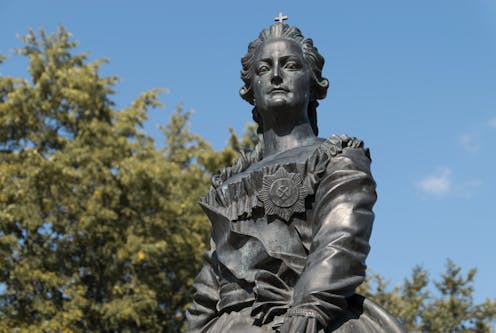
In his speech legitimizing Russia’s annexation of Crimea in 2014, Vladimir Putin invoked 18th-century history.
It was, after all, Catherine II (also known as Catherine the Great) who had first acquired the peninsula for Russia at the same time she seized what is now Belarusian territory in the first partition of the Polish-Lithuanian Commonwealth.
In the second partition 21 years later, Catherine acquired extensive lands lying today in both Belarus and Ukraine. She amassed even more two years later, in Poland-Lithuania’s final partition.
The parallels between Catherine’s and Putin’s designs on these territories are remarkable, and even though Ukraine’s future currently looks bleak, historical comparison offers grim hope.
Meddling in Poland
Russia’s meddling in foreign elections did not begin in 2016. Poland (as the multi-ethnic commonwealth was called for short) had an elective monarchy in the 18th century, and Russia regularly intervened to ensure that its preferred candidate won.
In 1764, Catherine dispatched an army to Warsaw to see that one of her lovers, Stanisław Poniatowski, was elected king, declaring that she was acting “to defend the republic’s freedoms.” She expected Poniatowski to keep Poland weak, but he surprised her by undertaking modernizing reforms.

Catherine responded by covertly organizing militias of Poland’s Protestant and Orthodox minorities, and secretly financing a rival Catholic militia, which plunged the commonwealth into civil war.
Poland’s only significant ally, the Ottoman Empire, protested, but Catherine replied that she knew nothing of purported Russian interference. Alarmed Poles formed a fourth, anti-Russian militia and appealed to the Turks for aid, sparking a war in which Catherine wrested Crimea and most of what is now Ukraine’s Black Sea coast from the Ottoman Empire.
A 1774 treaty guaranteed Crimea’s independence, but nine years later Catherine unilaterally annexed it.
Partitions of Poland
Meanwhile, another enlightened despot — Prussia’s Frederick II (also known as Frederick the Great) — proposed the first partition of Poland, getting Catherine and Austria’s Maria Theresa to agree by raising the spectre that each might have to fight the other two if they didn’t co-operate.
Losing 30 per cent of the commonwealth’s territory shocked Poland’s nobility into greater openness to reform. When Russia was distracted by another war with Turkey in 1791, Poland adopted the world’s second written constitution.
Not all Poles supported this innovation, and in the winter of 1791-92, Catherine summoned their representatives to St. Petersburg, where they plotted the constitution’s overthrow. Catherine’s Polish accomplices declared a rebellion, and four days later Russian troops invaded.

Tadeusz Kościuszko, the American revolutionary war veteran now in charge of Poland’s army, led a successful resistance — until King Stanisław, who had supported the constitution, switched sides and Kościuszko’s army dissolved in confusion. The second Polish partition followed.
Kościuszko and other patriots returned from exile in 1794 for a final, revolutionary attempt to restore Polish independence. So many commoners flocked to their cause that they enjoyed initial success, but ultimately could not overpower Russia’s and Prussia’s combined might. In 1795, the third partition liquidated the Polish state for 123 years.
Putin parallels
Parallels with Putin’s strategy are striking. The “little green men” who occupied Crimea in 2014, concealing their identity as Russian soldiers, recall Catherine’s tactic of surreptitiously fomenting civil war in Poland.
Her financing of foreign politicians to weaken potential resistance, along with her rhetoric of defending freedom, anticipated the so-called hybrid warfare Putin has used to great effect across Europe and beyond.
Read more: Explainer: what is 'hybrid warfare' and what is meant by the 'grey zone'?
Putin even claims to defend ethnic Russians abroad just as Catherine did Orthodox Christians. And just as Catherine had fans in the West who approved of Polish subjects coming under her “enlightened” rule, so too do some westerners believe Putin’s propaganda of “de-Nazifying” Ukraine and defending “European” values.
Though no historical comparison is perfect, Putin’s motives are clearly the same as Catherine’s — to expand Russian power wherever possible. Catherine sought at all costs to keep Poland from reforming itself; when it was no longer possible to dominate it as an unofficial protectorate, she annexed as much of it as possible.

Ukrainians ‘indigestible’
Since 2004, Ukraine has repeatedly struggled to reform itself, and this Putin cannot allow. If protectorate status is impossible, he will opt for annexation.
But comparing Catherine and Putin also suggests a certain hope for Ukraine. As philosopher Jean-Jacques Rousseau advised Poles in 1772:
“You may not be able to keep them from swallowing you; at least make it so they cannot digest you …. Establish the republic in Poles’ own heart.”
This was eventually how Poland survived in exile and underground until circumstances facilitated its rebirth.
Kyiv’s Euromaidan revolution of 2013-14 resurrected Ukraine in the hearts of its citizens, and their heroic resistance today shows that they too will ultimately be indigestible. Though Putin, through horrific violence, may achieve a military victory, the spiritual fight is one he ultimately cannot win.
James Krapfl does not work for, consult, own shares in or receive funding from any company or organisation that would benefit from this article, and has disclosed no relevant affiliations beyond their academic appointment.
This article was originally published on The Conversation. Read the original article.







